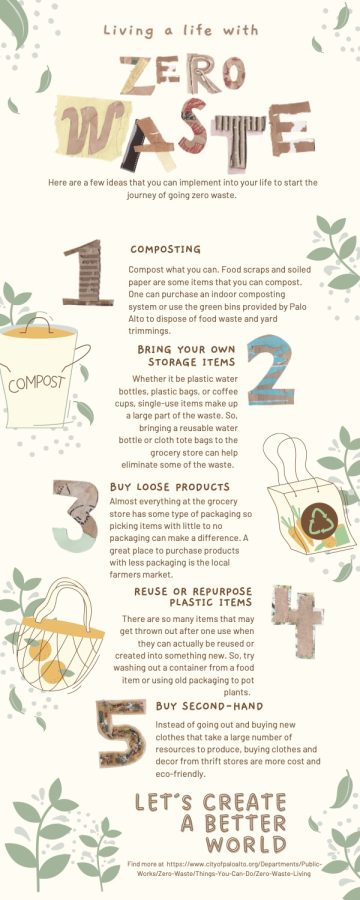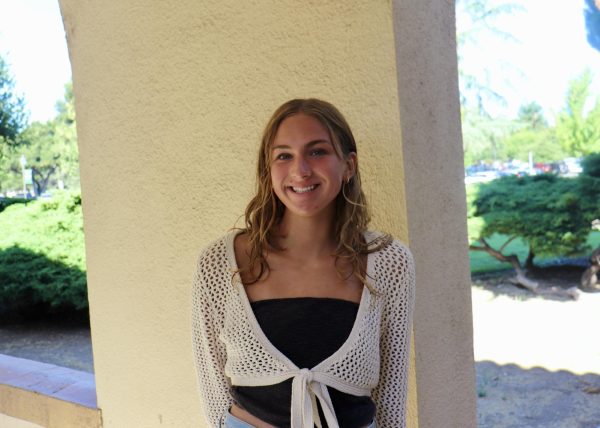A Change to Zero Waste
With the threats of climate change accelerating, local initiatives are being made to go to zero waste.
As society advances, it almost feels like we are living in a world wrapped in plastic. Whether it be the plastic tube of toothpaste we use to brush our teeth or the food we buy from the grocery store, packaging consumes the modern world. This new plastic world is causing a number of problems that all have the same solution: going zero waste.
According to the Environment America Research and Policy Center, the average American throws out 4.9 pounds of trash per day, creating nearly 1,800 pounds of material per person a year4.
This massive amount of trash produced unfolds into a variety of issues including greenhouse gas emission, physical pollution from littering or improper disposal, and the large amount of space it takes once it is disposed of.
While one might not immediately think that plastic and organic material, such as food waste, release a substantial amount of greenhouse gasses, roughly 42% of U.S. greenhouse gasses are created in the process of extracting resources, producing goods, disposing of waste, and transporting materials at every stage of the processes4.
Michael Capello, an environmental specialist working with Zero Waste Palo Alto, elaborates on one way that greenhouse gasses are released in the disposal of waste.
“An issue that not only the City of Palo Alto but also environmental programs worldwide have to face is the organic material that goes into the landfill,” Capello said. “Over time that organic material breaks down and one of the byproducts of that process is methane emissions.”
Methane is a gas that is composed of both hydrogen and carbon, and when emitted becomes a dangerous greenhouse gas.
Greenhouse gasses trap heat in the atmosphere, and although necessary to a certain extent, the rate at which they are currently being produced is too high and the temperature of the atmosphere is increasing3.
This rise in temperature, also known as climate change, has a domino effect on the ecosystems and natural processes around the world making it an incredibly important problem to address. Not only does waste contribute to climate change but problems also arise regarding improper disposal of waste.
According to the article “The Lifecycle of Plastics” published by the World Wildlife Fund, up to 130,000 tonnes of plastic per year will end up in the ocean as plastic pollution2.
This plastic pollution can result in a number of problems including entanglement and consumption which can result in serious injury and death to wildlife.
Furthermore, even if this waste is properly disposed of it takes up a large amount of land, which is already a limited resource.
While a multitude of solutions have been discussed to mitigate these problems the only way to address all of the consequences is to go zero waste.
The term zero waste can be interpreted in a few different ways but is largely acknowledged as the process of redesigning the products and consumption of products in a manner that all materials can be reused or recycled or not needed at all so that no waste is created5.
This process may seem daunting but as climate change accelerates, going zero waste as a city and as an individual will be essential for the protection of the environment.
Luckily, the city of Palo Alto is working with Capello and Zero Waste Palo Alto to reach their mission of “virtually eliminating waste”6. But this mission does have its challenges.
“It is just like any learned behavior, we have done it for so long that these habits have become deeply integrated in our lives,” Capello said. “It can be overwhelming for people because it takes active work and sometimes it just feels easier to ignore the problem.”
Yet, this is a problem that can not be ignored forever, so Capello is working on helping make the process less overwhelming by raising awareness and removing the barriers that may exist between citizens and the scientific language used to describe the importance of the issue.
“Our [Zero Waste Palo Alto’s] goal is to work with not only the residents but also the businesses to make progress and get closer and closer to that goal of truly becoming zero waste,” Capello said.
This goal can be achieved in a variety of ways, and if each person can easily implement a few into their daily lives, eventually, they will become new habits. These small actions add together to make a difference in achieving a zero waste city.
“We don’t need one person perfectly creating zero waste,” Capello said. “We need all the people imperfectly creating less waste.”
Works Cited
- Jamie. “Zero Waste Living: 35 Ways to Start Reducing Waste.” Eco Friendly Habits, 4 Jan. 2022, www.ecofriendlyhabits.com/zero-waste-living/.
- “The Lifecycle of Plastics.” WWF Australia, 1 July 2021, wwf.org.au/blogs/the-lifecycle-of-plastics/#gs.egzrxx.
- “Overview of Greenhouse Gases.” EPA, 13 Apr. 2023, www.epa.gov/ghgemissions/overview-greenhouse-gases.
- Rakov, Susan. “Trash in America.” Environment America Research & Policy Center, 25 May 2023, environmentamerica.org/center/resources/trash-in-america-2/#:~:text=Americans%20throw%20out%204.9%20pounds,landfills%20or%20burned%20in%20incinerators.
- “Zero Waste.” CalRecycle, 2023, calrecycle.ca.gov/zerowaste/.
- “Zero Waste.” City of Palo Alto, 11 Apr. 2023, www.cityofpaloalto.org/Departments/Public-Works/Zero-Waste.


2022-2023 Staff Writer
2023-2024 Managing Editor
I joined C Mag as a way to express my creative side and advocate for subjects I am passionate about....







![Polynesian Club Performs at the Cultural Celebration Assembly
[Photo Courtesy of Savannah Earley]](https://cmagazine.org/wp-content/uploads/2025/04/PNG-image-600x535.jpeg)